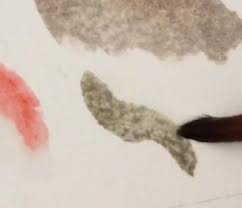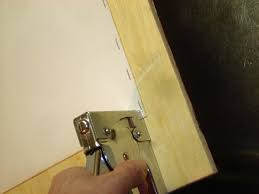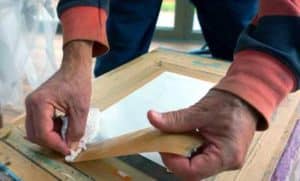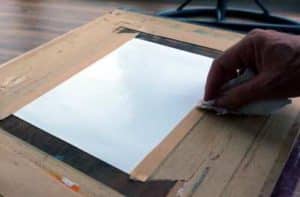Stretching Watercolour Paper
Why stretch: Taut Paper
I am always surprised how many artists do not stretch their paper. I have always stretched my paper, i hate when the paper cockles/expands, watercolour painting is difficult enough without having puddles forming where you do not want them. I guess it depends how much water you use and your style and technique.

Brown tape could not hold paper as it dried and returned to original size.

Staples could not hold paper

Damaged or unsized paper turns to blotting paper.

Watercolour Sizing:
Stretching paper is a pretty simple task: when you know how. However i have encountered a few problems over the years.
Watercolour Paper is sized with a delicate gelatin to slow down the speed of absorbtion. This is what gives you time to paint, to be able to lay a wash slowly without it drying too fast and to be able to remove paint before it dries, without this the paint is absorbed instantly , like blotting paper and leaves your colours dull.
Papers can be internally or externally sized or both, and all brands are slighly different.
The gelatin sizing can be destroyed if you:
- soak it too long,
- restretch it a second or maybe third time,
- use hot water,
- Leave it in hot sunlight,
- store the paper incorrectly,
- the paper is too old.
- if you scrub the paper too much.
- Try not to touch the paper with your hands to avoid leaving any grease on the paper.
The result being that the paper will absorb the paint immediately, like blotting paper, leaving horrible dull colours, impossible to work with.
If you soak it too long the paper will also grow too much and when it dries and tries to return to its original size it will tear from staples and brown tape.
Therefore the amount of time left immersed in water is very important.
It is extremely annoying to sketch out your painting only to find the sizing has dissapeared when laying your first wash. This can happen in a few weeks of stretching your paper especially in hot sunny weather.
Try not to stretch your paper too far in advance, stretch it just when you need it, then keep it under plastic until you need it.
keep it out of the sunlight.
Wetting the paper
I used to soak the paper in a few inches of bath water, but as i will explain in my new method, i now find this unnecessary.
How much you need wet and stretch the paper will depend on how much water you use when you are painting, the humidity of your enviroment, the paper thickness and the absorbency of the board.
- hold the paper to the light to see the manufacturers water mark if there is one, to determine which side is the front and back.
- Put the paper face down on the board so you can wet the back of the paper first.
- take a clean watercolour sponge fully loaded with water and starting at top left or right gently wipe across the page so the paper is completely wet as you move down the page, reloading the sponge with water as necessary.
- once you reach the bottom, turn over the page, lay flat in it’s final resting position and repeat the process, wetting the page from top to bottom.
- The paper should all completely glisten with water, hold it upto the light at an angle to check for any dry spots.
- Now comes the tricky part: how long? i will say 10-20 mins this will depend on humidity in your enviroment and the papers characteristics, sizing, weight etc.
- First try 10 mins then check for dry spots, spray any with wateror wet with another songing so it glistens again.
- 10 mins later it should be ready to secure to your board .



Stapling on to Thick Wooden Board
When i am stretching onto a thick wooden board say min 10mm I use:
A large Hand Held Staple Gun and 6mm long staples.
- When the paper has been wet with the sponge as above, lay flat on your board.
- I staple every 4cm more or less around the perimeter around 1.5cm from the edge.
- Now leave flat to dry for 24hrs +/-
With Brown Tape onto thin MDF or Coreflute.
When i am stretching onto core flute or thin mdf 6mm it is not possible to use staples I use the brown paper parcel tape that you need to wet to stick.
I stretch as little as possible, wetting just one side of the paper, otherwise the board will bend too much as it dries, a littl bending is o.k.
Your board will need to be around 6cm longer and wider than the paper.
If you use the brown parcel tape that needs water you must make sure the surface on which you are going to stretch it onto is slightly porous and can adhere well. Even then if you expand the paper too much before sticking it will probably not hold the paper as it shrinks.
- When the paper has been wet with the sponge as above, lay flat on your board.
- tear strips of brown tape 2-3cm longer than the side lenghts of the paper.
- With a wet paper towel, wipe the gummed side of the brown parcel tape, place half on the paper half on the board gummed side down, using the same paper towel wipe the top of the tape down.
- Now place the tape along the edge of the paper so half is on the paper and half on the board.
- wipe the tape with a piece of kitchen roll.
- Leave flat to dry.
Note: If your board is shiny the tape may not stick to the board as it dries, you can get round this by:
- Permanently glueing a large piece of card on the entire board and when it’s dry stretching your paper on this so the tape is sticking to card not shiny board.
- Mixing wood glue with water to apply to the tape.




Note: If you use extreme amounts of water in your paintings you may want to follow Nita Engle’s advice to staple your paper and use carpenter’s glue on the brown gummed paper for extra strength as it shrinks.

Paper Storage
Paper should be stored in a flat, dry enviroment ideally 45% humidity and not exceeding 30%-70%.
Keep it in it’s plastic bag.
Fine Food Cuisine
I am text block. Click edit button to change this text. Lorem ipsum dolor sit amet, consectetur adipiscing elit. Ut elit tellus, luctus nec ullamcorper mattis, pulvinar dapibus leo.

